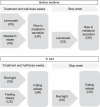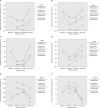Classical conditioning for preserving the effects of short melatonin treatment in children with delayed sleep: a pilot study
- PMID: 28331380
- PMCID: PMC5352231
- DOI: 10.2147/NSS.S129203
Classical conditioning for preserving the effects of short melatonin treatment in children with delayed sleep: a pilot study
Abstract
Melatonin treatment is effective in treating sleep onset problems in children with delayed melatonin onset, but effects usually disappear when treatment is discontinued. In this pilot study, we investigated whether classical conditioning might help in preserving treatment effects of melatonin in children with sleep onset problems, with and without comorbid attention deficit hyperactivity disorder (ADHD) or autism. After a baseline week, 16 children (mean age: 9.92 years, 31% ADHD/autism) received melatonin treatment for 3 weeks and then gradually discontinued the treatment. Classical conditioning was applied by having children drink organic lemonade while taking melatonin and by using a dim red light lamp that was turned on when children went to bed. Results were compared with a group of 41 children (mean age: 9.43 years, 34% ADHD/autism) who received melatonin without classical conditioning. Melatonin treatment was effective in advancing dim light melatonin onset and reducing sleep onset problems, and positive effects were found on health and behavior problems. After stopping melatonin, sleep returned to baseline levels. We found that for children without comorbidity in the experimental group, sleep latency and sleep start delayed less in the stop week, which suggests an effect of classical conditioning. However, classical conditioning seems counterproductive in children with ADHD or autism. Further research is needed to establish these results and to examine other ways to preserve melatonin treatment effects, for example, by applying morning light.
Keywords: children; classical conditioning; delayed sleep; melatonin.
Conflict of interest statement
Disclosure The authors report no conflicts of interest in this work.
Figures



References
-
- Spruyt K, O’Brien LM, Cluydts R, Verleye GB, Ferri R. Odds, prevalence and predictors of sleep problems in school-age normal children. J Sleep Res. 2005;14(2):163–176. - PubMed
-
- Dewald JF, Meijer AM, Oort FJ, Kerkhof GA, Bögels SM. The influence of sleep quality, sleep duration and sleepiness on school performance in children and adolescents: a meta-analytic review. Sleep Med Rev. 2010;14(3):179–189. - PubMed
-
- Fallone G, Owens JA, Deane J. Sleepiness in children and adolescents: clinical implications. Sleep Med Rev. 2002;6(4):287–306. - PubMed
-
- Gregory AM, O’Connor TG. Sleep problems in childhood: a longitudinal study of developmental change and association with behavioral problems. J Am Acad Child Adolesc Psychiatry. 2002;41(8):964–971. - PubMed
LinkOut - more resources
Full Text Sources
Other Literature Sources

